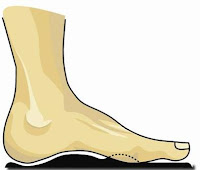
Last December I wrote a Post about the barefoot running phenomenon. I quoted proponents and cautions from the American Podiatric Medical Association. I wondered if it was wise to run barefoot when so many experts felt it would be very risky. In the past year the cautionary voices have not changed but the proponent voices have reached a critical mass. Anecdotal, experiential and theoretical support for the benefits of barefoot running is everywhere. Enough people have run barefoot for enough time now to "prove" that barefoot running does not inevitably cause terrible foot problems. In fact, many runners who had foot problems have found that running barefoot has allowed them to resume their favorite sport pain free.
Of course all proponents agree that there is a new technique to learn. You cannot run barefoot the same way you run with a thickly cushioned, classic running shoe. In a nut shell the change in technique is to shorten the stride and strike on the mid-forefoot arch area rather than the heel. Here is a link to Dr. Oz demonstrating the correct technique (at the 3.47 minute mark). By the way at the 3.13 minute mark Dr. Oz talks about orthotics and uses a pair of Pedag Viva!
At least one barefoot running shoe is now made by the top athletic shoe manufacturers. Shoe stores and athletic shoe stores now all sell this fast growing category.
I think that Pedag Viva is the ideal orthotic to wear while you see if barefoot running is right for you.
· Viva is thin enough to fit into your barefoot running shoe.
· Viva will not add bulk and will allow the foot to feel the running surface.
· Viva will not interfere with the proper technique needed to run barefoot but it will support
the arches while you test this new technique.
· Using Viva will be a good way to begin barefoot running while your build up your foot's
muscles.
Of course all proponents agree that there is a new technique to learn. You cannot run barefoot the same way you run with a thickly cushioned, classic running shoe. In a nut shell the change in technique is to shorten the stride and strike on the mid-forefoot arch area rather than the heel. Here is a link to Dr. Oz demonstrating the correct technique (at the 3.47 minute mark). By the way at the 3.13 minute mark Dr. Oz talks about orthotics and uses a pair of Pedag Viva!
At least one barefoot running shoe is now made by the top athletic shoe manufacturers. Shoe stores and athletic shoe stores now all sell this fast growing category.
I think that Pedag Viva is the ideal orthotic to wear while you see if barefoot running is right for you.
· Viva is thin enough to fit into your barefoot running shoe.
· Viva will not add bulk and will allow the foot to feel the running surface.
· Viva will not interfere with the proper technique needed to run barefoot but it will support
the arches while you test this new technique.
· Using Viva will be a good way to begin barefoot running while your build up your foot's
muscles.















